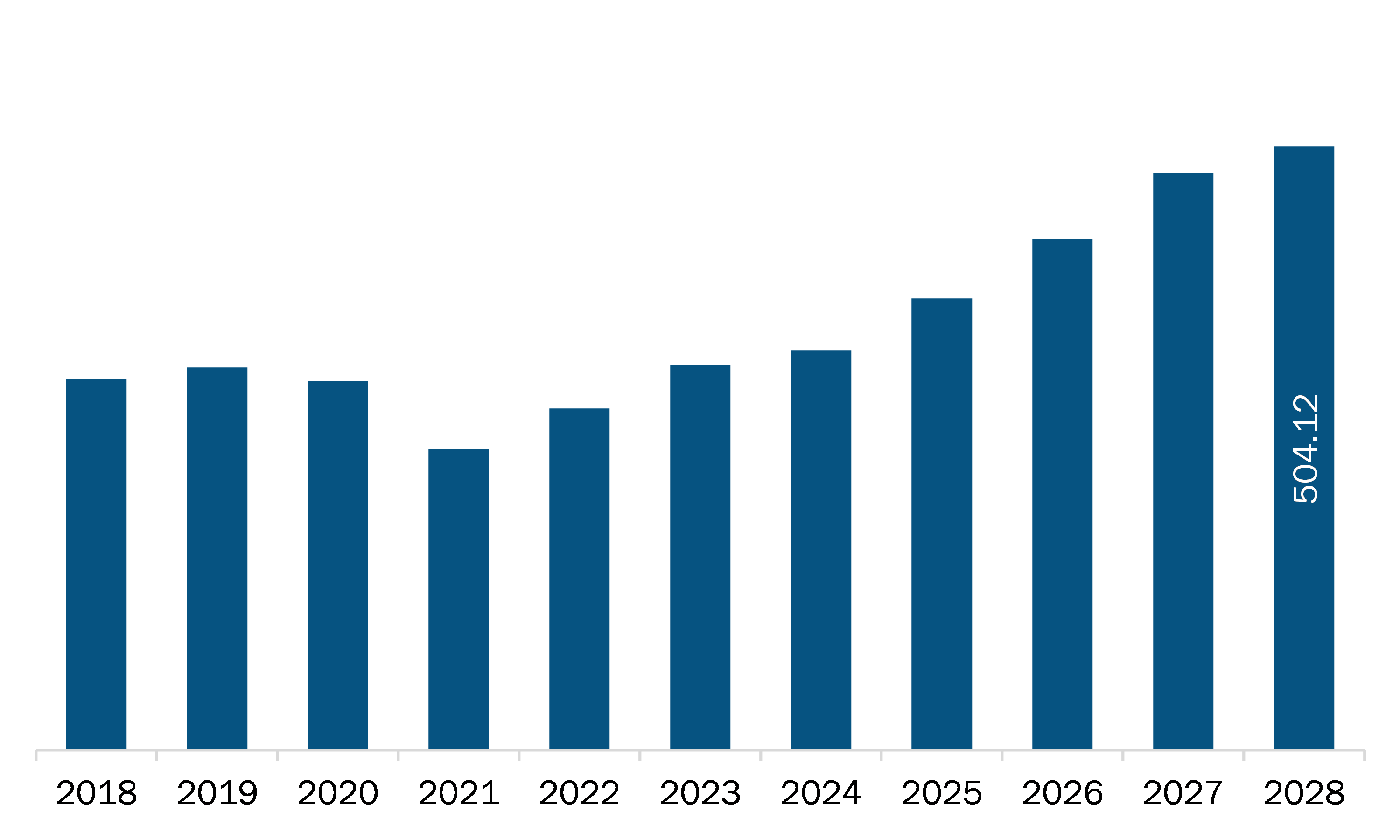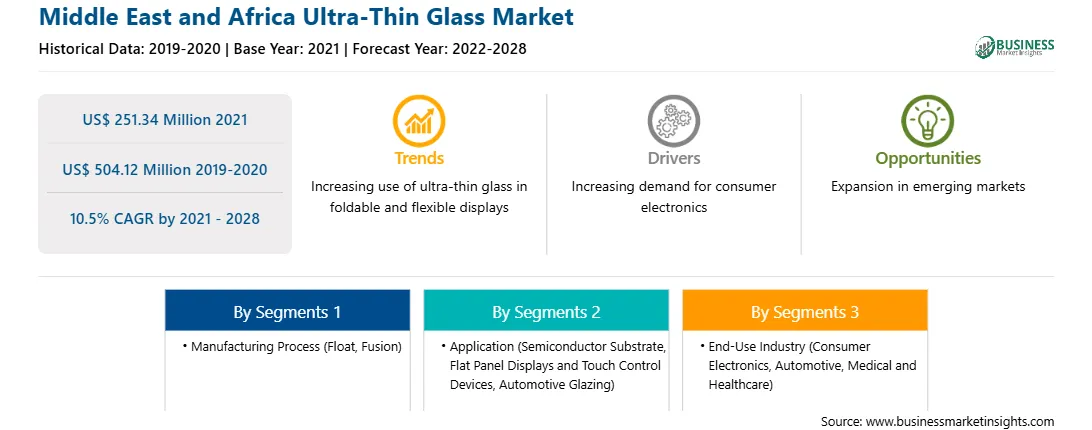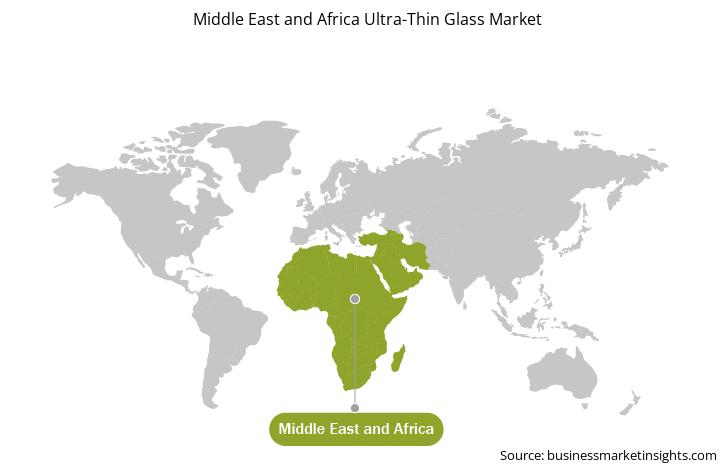The MEA ultra-thin glass market is segmented into South Africa, Saudi Arabia, the UAE, and the Rest of the MEA. This region has witnessed a significant economic surge leading to change in lifestyles of people and increased spending power of consumers. As the lifestyle of people across the region is improving, the demand for consumer electronic products is also expected to increase in the region. The rising prominence of smartphones, laptops, smartwatches, and other such devices among the younger population of the region is projected to support the growth of the ultra-thin glass market over the forecast period. Ultra-thin glass has extensive application across the electronics sector as it is used in touch and display panels, electronic and optical sensors, energy storage devices, and semiconductors. The demand for electronic devices such as LCDs, LEDs, OLEDs, smartphones, monitors, and laptops across the region is expected to increase in the near future, which will boost the use of ultra-thin glass.
In MEA, South Africa and Israel recorded the highest number of COVID-19 confirmed cases and deaths. According to the International Finance Corporation, the COVID-19 pandemic has a severe impact on the economy of MEA as it declined the oil production, tourism, and remittances. The region comprises many growing economies, which are prospective markets for ultra-thin glass vendors. The pandemic has significantly slowed down the growth of the ultra-thin glass market in the region due to negative impact on the growth of a few industries, such as automotive.

Strategic insights for the Middle East and Africa Ultra-Thin Glass provides data-driven analysis of the industry landscape, including current trends, key players, and regional nuances. These insights offer actionable recommendations, enabling readers to differentiate themselves from competitors by identifying untapped segments or developing unique value propositions. Leveraging data analytics, these insights help industry players anticipate the market shifts, whether investors, manufacturers, or other stakeholders. A future-oriented perspective is essential, helping stakeholders anticipate market shifts and position themselves for long-term success in this dynamic region. Ultimately, effective strategic insights empower readers to make informed decisions that drive profitability and achieve their business objectives within the market.

| Report Attribute | Details |
|---|---|
| Market size in 2021 | US$ 251.34 Million |
| Market Size by 2028 | US$ 504.12 Million |
| Global CAGR (2021 - 2028) | 10.5% |
| Historical Data | 2019-2020 |
| Forecast period | 2022-2028 |
| Segments Covered |
By Manufacturing Process
|
| Regions and Countries Covered | Middle East and Africa
|
| Market leaders and key company profiles |
The geographic scope of the Middle East and Africa Ultra-Thin Glass refers to the specific areas in which a business operates and competes. Understanding local distinctions, such as diverse consumer preferences (e.g., demand for specific plug types or battery backup durations), varying economic conditions, and regulatory environments, is crucial for tailoring strategies to specific markets. Businesses can expand their reach by identifying underserved areas or adapting their offerings to meet local demands. A clear market focus allows for more effective resource allocation, targeted marketing campaigns, and better positioning against local competitors, ultimately driving growth in those targeted areas.

The ultra-thin glass market in MEA is expected to grow from US$ 251.34 million in 2021 to US$ 504.12 million by 2028; it is estimated to grow at a CAGR of 10.5% from 2021 to 2028. The ultra-thin glass market across the region is also being influenced by the rising demand for smart wearable devices such as fitness bands and smartwatches. These smart wearable devices require a lightweight display that is scratch-resistant, heat-resistant, water-resistant, and weather-resistant, as well as having a longer battery life. Ultra-thin glass reduces the overall weight of the device, making it highly convenient to use. Thus, the growing demand for smart wearable devices across the region is expected to propel the growth of the ultra-thin glass market during the forecast period. The MEA region is expected to provide lucrative opportunities for the ultra-thin glass market, owing to soaring electronics sales, coupled with increasing consumer expenditure on electronic goods.
MEA ultra-thin glass market is segmented into manufacturing process, application, end-use industry, and country. Based on manufacturing process, the MEA ultra-thin glass market has been divided into float, fusion. Fusion segment held the largest market share in 2020. Based on application, the MEA ultra-thin glass market has been divided into semiconductor substrate, flat panel displays & touch control devices, automotive glazing, others. Flat panel display segment held the largest market share in 2020. Based on end-use, the MEA ultra-thin glass market has been divided into consumer electronics, automotive, medical & healthcare, others. Consumer electronics segment held the largest market share in 2020. Based on country, the MEA ultra-thin glass market is segmented into Saudi Arabia, South Africa, and UAE, and rest of MEA. Rest of MEA held the largest market share in 2020.
A few major primary and secondary sources referred to for preparing this report on the ultra-thin glass market in MEA are company websites, annual reports, financial reports, national government documents, and statistical database, among others. Major companies listed in the report are AGC Inc.; Corning Incorporated; CSG Holding Co., Ltd.; Emerge Glass; Nippon Sheet Glass Co., Ltd; SCHOTT AG; and Xinyi Glass Holdings Limited.
The Middle East and Africa Ultra-Thin Glass Market is valued at US$ 251.34 Million in 2021, it is projected to reach US$ 504.12 Million by 2028.
As per our report Middle East and Africa Ultra-Thin Glass Market, the market size is valued at US$ 251.34 Million in 2021, projecting it to reach US$ 504.12 Million by 2028. This translates to a CAGR of approximately 10.5% during the forecast period.
The Middle East and Africa Ultra-Thin Glass Market report typically cover these key segments-
The historic period, base year, and forecast period can vary slightly depending on the specific market research report. However, for the Middle East and Africa Ultra-Thin Glass Market report:
The Middle East and Africa Ultra-Thin Glass Market is populated by several key players, each contributing to its growth and innovation. Some of the major players include:
The Middle East and Africa Ultra-Thin Glass Market report is valuable for diverse stakeholders, including:
Essentially, anyone involved in or considering involvement in the Middle East and Africa Ultra-Thin Glass Market value chain can benefit from the information contained in a comprehensive market report.